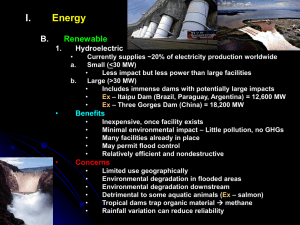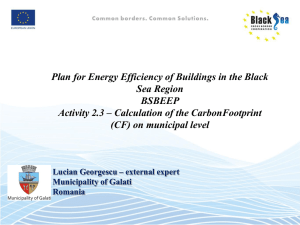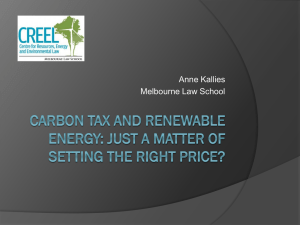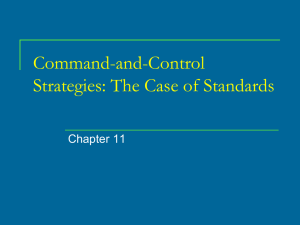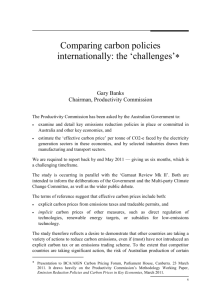carbon-abatement-effects-of-electricity-demand-reductions
advertisement
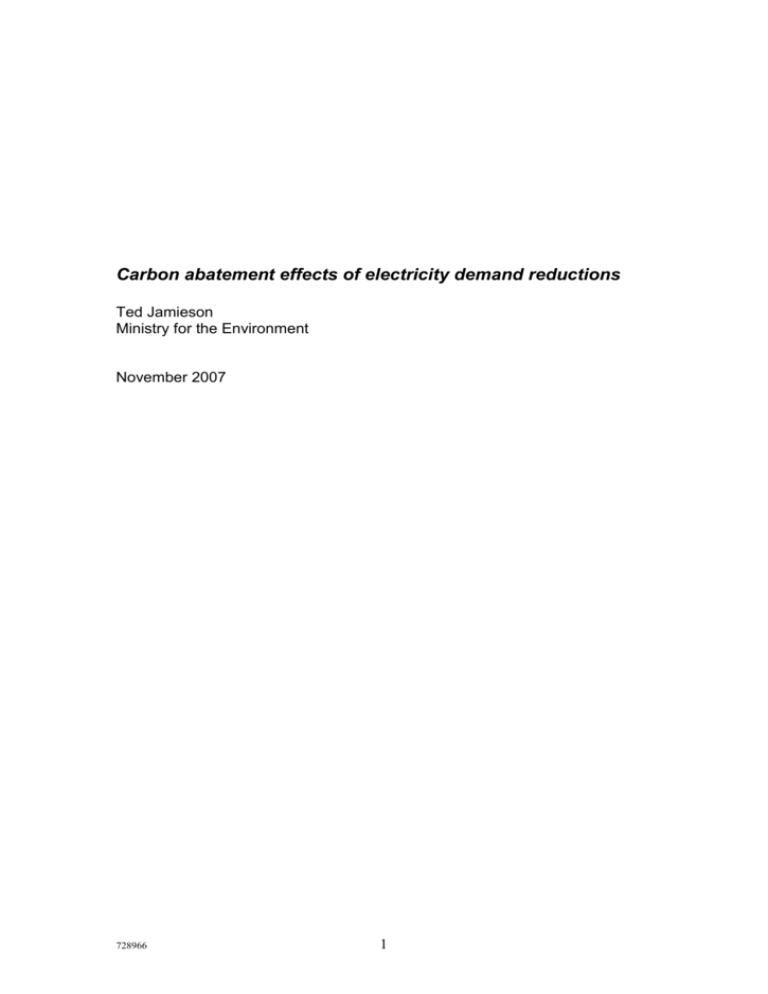
Carbon abatement effects of electricity demand reductions Ted Jamieson Ministry for the Environment November 2007 728966 1 Foreword If we reduce the demand for electricity in New Zealand, how much of a reduction in greenhouse gas emissions would result? This is a question that frequently arises in analysis of government policy. Unfortunately, there is no simple answer. One should properly analyze the impacts of a specific change in electricity demand using a complete model of the electricity system, which can take into account time of day effects, transmission constraints, impacts on construction of new generation facilities (both renewable and fossil-fuelled), and how these and other factors come together to affect generation dispatching. Furthermore, even in a complete model of the electricity system, the impacts may vary greatly depending upon what assumptions one makes about how the electricity system will evolved over time, including demands, costs, and physical facilities. Clearly, a thorough analysis of any specific demand reduction represents a significant modelling effort. For this reason, it is useful to have some simple rules-of-thumb relating reductions in electricity demand to reductions in greenhouse gas emissions. Such rules-of-thumb are useful for doing a preliminary analysis of any policy that might affect electricity demand. They are also useful for doing a more definitive analysis of any policy whose impacts on electricity demand are relatively small, meaning that extensive modelling of the complete electricity system is difficult to justify. This paper describes work that was done with a focus on developing such rule-of-thumb abatement factors. The results are based on a series of runs of the Electricity Commission’s market model, known as GEM, which is a fairly comprehensive model of the New Zealand electricity system. This paper represents one of the first published outputs of an initiative known as Energy Data Analysis and Coordination (EDAC) to improve accountability and coordination in energy statistics and modelling across the New Zealand government. The EDAC group would especially like to thank Ted Jamieson of the Ministry for the Environment, as well as Brian Bull and Phil Bishop of the Electricity Commission, for their efforts in making this paper possible. Ralph Samuelson Ministry of Economic Development for the EDAC Group 728966 2 Purpose This paper reviews the results of modelling recently carried out by the Electricity Commission, and recommends abatement factor(s) that can be used to assess the emission reduction effects of projects that reduce electricity use, for the next few years and in the longer term. This can be seen as updating the modelling done for the Projects to Reduce Emissions (PRE) programme which gave an abatement factor of 0.6 tCO2-e/MWh1. Modelling results The EC has carried out an exercise using the GEM electricity market model to assess the abatement factor over the ten years 2007-16. Eight situations were considered involving combinations of: A cost for carbon emissions of zero, $15, $25, and $50 per tonne of CO2-e. The carbon charge is assumed to come in for the 2009 year and be maintained at a constant level over time. (Since this work was completed, the government has announced that emissions trading for electricity and stationary energy will begin in 2010.2) For each level of carbon charge, an assumption that the Otahuhu C station is built (labelled ‘OC’ in the graphs that follow) and starts operation for 2011, and the assumption that it is not built (‘No OC’). For each of these eight situations a pair of model runs was done, one as a baseline and one with 100MW less demand throughout the year. The baseline in each case is a ‘business as usual’ future in all respects except for the carbon charge and the Otahuhu C decision. Each pair of model runs thus simulates a one-off intervention that either reduces demand or increases renewable generation into the grid (the two are equivalent as far as the effect on emissions is concerned) and which is sustained over time. For each year the abatement factor is given by the difference in emissions between the baseline and low demand scenarios: Abatement Factor Baseline emissions Low demand emissions Baseline GWh delivered Low demand GWh delivered The model allows for transmission and distribution losses. It looks at the grid as a whole and integrates the effect for a whole year. Like the earlier PRE analysis, this work does not attempt to deal with the differing impacts that specific projects might have because of their location or timing. For instance a project in the South Island will have very different effects on emissions than one located near Auckland. Similarly, the effects of 1 See Ministry for the Environment, Projects to Reduce Emissions programme - electricity emission factors, http://www.mfe.govt.nz/publications/climate/electricity-emissions-factorreports/index.html 2 See Ministry for the Environment, The Framework for a New Zealand Emissions Trading Scheme, September 2007, http://www.climatechange.govt.nz/files/emissions-trading-schemecomplete.pdf, Section 4.3. 728966 3 a reduction at peak demand times will not be the same as off-peak. The modelling done here averages out these effects. The total emissions for the generation sector in these scenarios are shown in Figure 1 below. The results indicate, in summary: 1. Total annual CO2-e emissions from the generation sector, in these scenarios, are predicted to range from about five to seven million tonnes up to the year 2013. After that time, emissions increase sharply in the zero and $15 carbon price scenarios. Higher carbon prices limit emissions to a maximum of about 6.5 Mt with no increase after 2013. 2. Other things equal, the construction of Otahuhu C would increase emissions by about 0.5-0.8 Mt CO2-e per year up to the year 2015. This suggests that Otahuhu C would compete with renewable alternatives rather than with Huntly. Baseline generation GHG emissions MtCO2-e 10.0 9.0 2 No OC-0 No OC-15 No OC-25 No OC-50 OC-0 OC-15 OC-25 OC-50 8.0 7.0 6.0 5.0 4.0 3.0 2006 2008 2010 2012 2014 2016 2018 Year Figure 1 The calculated emission abatement factors for all scenarios are shown in Figure 2. The results indicate, in summary: 1. The short-term impact of a demand reduction on emissions (that is, in the current year and up to four years out in some scenarios) is 0.60 tCO2-e/MWh or more, consistent with the earlier PRE analysis. In the short-term, the effect of reduced demand is to reduce operation of existing generation plant, especially the thermal generators. 2. After a four-year transition period, the abatement factor comes down to lower figures on average. This is the result of the fact that, over time, 728966 4 the change in demand affects the investments that are made in new plant as well as the operation of the market. The impact on the operation of existing plants largely ‘fades out’ over the four years. 3. In the scenarios with no carbon price, or a low price, this longer-term abatement factor varies over a wide range, because the demand reduction is competing with a number of different options for new generation. Some of these are fossil fuel and some are renewable; a reduction in demand may offset renewables at one point in time, and coal at another time. 4. At several points in the no- and low-carbon-price scenarios, the abatement factor actually goes below zero. This is the result of situations in which particular renewable generation investments occur in the baseline, but are delayed in the low-demand scenario. Consequently, existing thermal plants generate more until the renewable alternative is eventually built. 5. For the high carbon price scenarios, the variability disappears because new generation investment is consistently going into renewables. In a market with significant carbon pricing, the long-term abatement factor settles in the range of zero to 0.2 tCO2-e/MWh. This indicates that there is still some net effect on the operation of fossil plant. Emission Factors 1.00 Abatement Factor tCO2-e/MWh 0.80 0.60 No OC-0 No OC-15 No OC-25 No OC-50 OC-0 OC-15 OC-25 OC-50 0.40 0.20 0.00 -0.20 -0.40 -0.60 -0.80 2006 2008 2010 2012 2014 2016 2018 Year Figure 2 Implications of the results The modelling covered a range of baselines from no supply-side policy to an effective carbon price. At one end of the range the baseline is ‘no policy other than the reduction we are modelling’; clearly this leaves substantial scope for 728966 5 any demand reduction measures to achieve additional medium-term abatement as they will be reducing fossil generation on an ongoing basis. Even in this case, though, at particular times in the life of an intervention it will reduce or offset renewable generation and achieve no abatement. If the immediate future does not include effective emission pricing or equivalent policies to influence supply-side investments, the recommended abatement factors would be: 0.6 tCO2-e/MWh for the short term (one to three years) 0.4 ± 0.2 tCO2-e/MWh for the medium term (years four to ten) 0.5 tCO2-e/MWh as an average for a ten-year project At the other end of the range, where the baseline includes a significant carbon price or equivalent policy, an intervention achieves similar abatement only for the first year or two. The impact then declines through years two to four, as the electricity market adjusts by building more renewable generation, and in the longer term only a small additional impact (on operation of fossil plants) is possible. This is shown in Figure 3 below. Emissions factors - $50 CO2-e price 1.00 Abatement Factor tCO2/MWh 0.80 0.60 0.40 0.20 No OC-50 OC-50 0.00 -0.20 -0.40 -0.60 -0.80 2006 2008 2010 2012 2014 2016 2018 Year Figure 3 This pattern would be likely to repeat itself if a similar intervention was modelled at a later time – there is a short-term response which fades over several years as the market adjusts and, as long as renewables dominate new construction, only a small ongoing impact. 728966 6 With emission pricing, recommended abatement factors are approximately: 0.6 tCO2-e/MWh for the short term (one to three years) 0.1 tCO2-e/MWh for the medium term (years four to ten) 0.2 tCO2-e/MWh as an average for a ten-year project In any longer-term future that features emission pricing or other measures that influence investment in the generation sector, there will be relatively little scope for demand side measures to achieve ongoing direct abatement. This does not mean that energy efficiency and demand side management are unimportant for the long term. It means that their benefits cannot be measured just in terms of quantifiable emission reductions. Demand side programmes contribute to economically efficient long-term emission management by overcoming the market barriers that hinder an adequate demand response to the cost of energy supply. In the longer term demand reduction measures may be the key to ensuring that demands on the generation system are held at a level that can feasibly be met with renewables. They may be best seen as part of a strategic direction that ensures New Zealand is on a path to such a long-term future, instead of a future in which fossil fuels will be seen as the only answer to the problem of ensuring reliable supply. In addition, all forms of energy supply have environmental impacts of one kind or another. Indeed renewables may have more serious local impacts than fossil fuel generation. Demand reduction programmes help to manage all of the environmental impacts associated with energy. 728966 7


